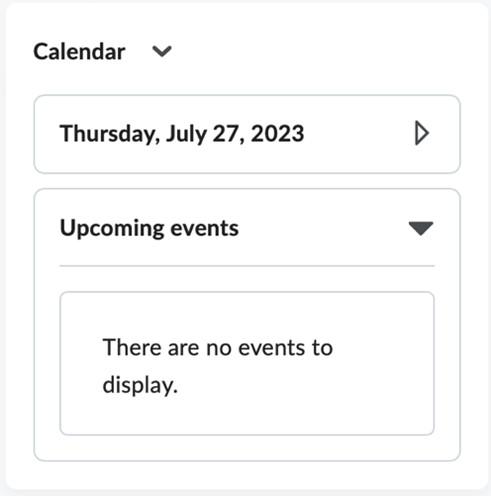
3
Academic Success Strategies
Academic Success Strategies

Learning Strategies Students Should Know
One of the biggest challenges students face while studying online is managing their time and other commitments. Falling behind when juggling other work, family and childcare can often take its toll on your academic success.
According to a 2013 study of online college students by Marie Fetzner, these were the top three reasons students felt they did not succeed in their online courses:
- I got behind and it was too hard to catch up.
- I had personal problems—health, jobs, childcare.
- I couldn't handle studying plus work or family responsibilities.
Don’t let this happen to you! Use these tips to write your own success story!
Stay current
Don't allow yourself to think, "I can always catch up later." Be diligent and stay current. Maintain precise organization even though you might have flexibility in your online courses.
Use built-in tools.
- Graded course items such as tests, assignments and graded discussions are automatically added to your calendars in Brightspace. Use your calendar daily — you can see due date reminders and other notifications in your announcements and activity feeds.
Log in early and regularly to your Brightspace and college email.
- At the beginning of each week or unit, review all course activities and assignments that are due that week. If you have questions, ask them early in the week so that you can still complete the work on time.
Anticipate technical difficulties.
- Be sure that you can receive technical assistance even if your computer isn't working. Because you can access your course from any internet-connected computer or device, having computer problems isn't usually an acceptable excuse for late work. Have an alternate method to get work done — a mobile device, or a family member’s or friend's laptop. If you need tech support, contact the Help Desk at 416-415-5000 x4357 or helpdesk@georgebrown.ca or use the Ask George chatbot in the MyGBC Student Portal. You can also borrow equipment from the Library.
If you do fall behind...
- ...and can't keep up with your course despite your best effort, ask your instructor or program coordinator for assistance as soon as possible.
Plan for the unplanned
All students experience personal challenges at some point. The difference between successfully riding out those storms and failing is how you anticipate and deal with life's unexpected events.
Communicate with your instructor.
- If you have emergencies of a personal nature, contact your instructors as soon as possible to let them know the situation. Maintain good communications between yourself, your instructors and even your classmates — even when you don't have problems. Remember, it's good practice to use your George Brown email for all communications with the college and your professors.
Get help.
- George Brown supports you with a variety of student services, such as counselling, accessible learning, tutoring and academic advising, so utilize these areas and ask for assistance when you need it. Check out the Resource Hub on how to get connected to these areas.
Create a cushion.
- Often, it's not a matter of "if" items of a personal nature will infringe on your academic work, but it's "when" they will. Plan ahead and leave yourself a cushion of time each week so that you can complete your weekly coursework even if personal situations arise.
Time management is key.
- Use good time management and planning skills so that you don’t leave your academic work to the last minute. Use the built-in calendar in Brightspace to help prioritize your tasks. There are also time management workshops throughout the semester that are run by student ambassadors, so keep an eye out for their events. More time management tactics are in the next module!
Work your coursework into your life
It will require effort to achieve a balance between school and your other responsibilities, but you can do it!
Set goals.
- Develop long- and short-term academic goals, with timeframes, for completing your work. Whether your goal is to complete a degree, or a certificate or to take a few courses for personal or professional growth, plan the time it will take to meet your goal while handling your other responsibilities. There are also goal-setting workshops throughout the semester that are run by student ambassadors, so keep an eye out for their events.
Integrate personal and course calendars.
You can integrate your Brightspace calendar into your Outlook calendar to ensure you are staying on top of coursework, assignments and due dates. You will need to log into both your Brightspace and Outlook to complete this task. Follow the steps below:
- Visit learn.georgebrown.ca and sign in with your student ID and password.
- On your dashboard, you will see a calendar widget on the lower right side of your screen. Click on the down arrow and then click “Subscribe.”

- Ensure you select “All Calendars and Tasks” from the drop down.
- A URL will appear with a subscription URL to your Brightspace calendar. Please note, if you select “download” an ics or iCal file will be created for everything currently in your calendar but will not reflect any changes.
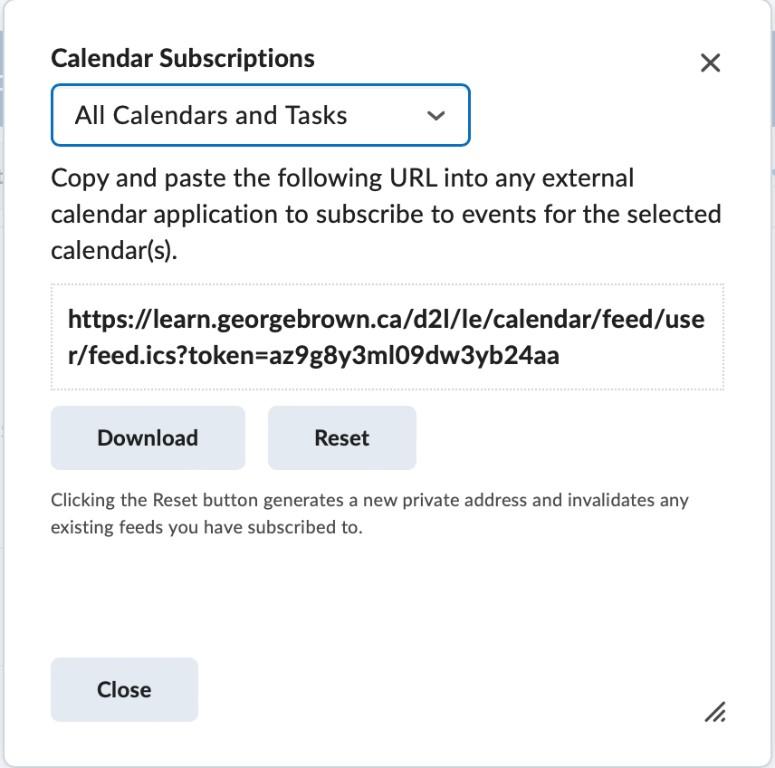
- Highlight the URL and copy it to your clipboard so you can use it in the next steps.
Now you will need to log into your GBC outlook in a web browser to continue.
- Visit https://portal.office.com/ and log in with your StudentID@georgebrown.ca and password.
- Select the Calendar icon from the left-hand navigation.
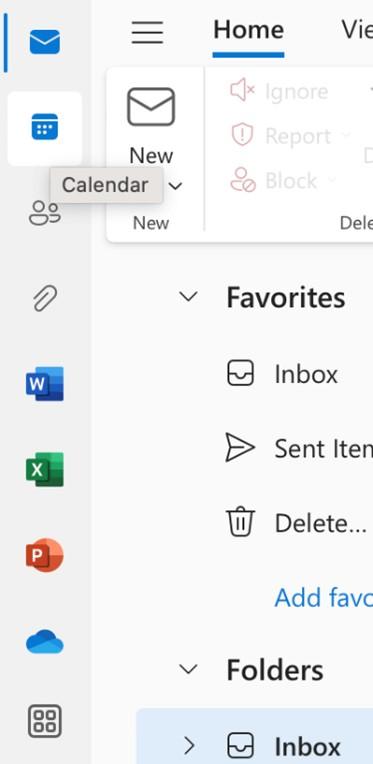
- In the navigation pane, select “Add Calendar.”

- Select “Subscribe from Web.”

- Enter the URL to your Brightspace calendar and name the calendar Brightspace.

- Select Import.
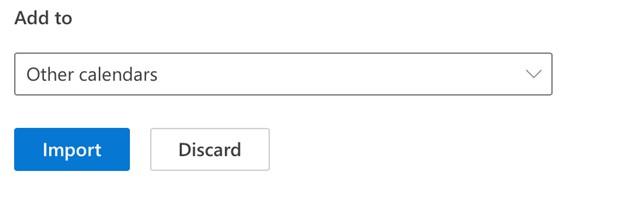
- Restart your Outlook app on your device and your Brightspace calendar is now integrated into your Outlook!
Treat your studies like your professional career
Your studies are part of your professional career. Make a conscious effort to be present, participate and be professional at all times. Always remember why you started and keep your long term goal clear in your mind! You never know if one of your classmates, instructors, or guest speakers may be a future colleague, boss, or business partner.
If you haven’t already, try searching your name on Google and see what comes up. You can also set up Google Alerts to monitor your footprint. Many employers will do a search on applicants. Remember, what your public profile looks like says a lot about you.
Before you start your semester take some time and update your online profiles associated with your studies to reflect your future vision. Try out these tips from LinkedIn for taking and selecting a professional photo that represents you.
Try to set (and keep!) boundaries, a schedule and daily goals to help you succeed in each course and project.
Make sure your studies are a top priority every day. Create a portfolio of your work to help motivate you and celebrate your wins along the way.
There are also personal brand workshops throughout the semester that are run by student ambassadors, so keep an eye out for their events.
Communicate Effectively Online
Communicating in an online course is typically different than in a face-to-face course. You must keep your tone in mind because you cannot make changes once you hit send.
Here is a list of the 7 Cs of Effective Communication in an Online Course, based on an article by Melissa Veneable. Before you get to the 7Cs, you need to remember to proofread everything you write before you press submit! Proofreading and grammar/spell-checking can really improve your success when communicating in your online course.
Clarity
You want your messages to be clear so that fellow students and your professor can understand the point you are trying to make. Proofreading your material or even letting someone else read it prior to posting can also be useful as they may show you problem areas (i.e. areas that are difficult to understand) that you are not aware of.
Completeness
You want to ensure you are answering any prompt or assignment completely. For instance, a prompt may have multiple parts you need to address. Even after writing your response, look back at the prompt to make sure you are addressing all of the necessary components.
Conciseness
I am sure many of you have heard the phrase, “short and sweet” to refer to the ideal length of time you should speak (e.g. in a presentation). Short and sweet is the key here. You want to communicate your point completely and effectively but remember less can be more. Most professors would prefer a shorter post that hits all of the key points than a long post that repeats the same points or goes on and on.
Correctness
Make sure that the message you are sending is correct containing accurate information. Utilize reliable sources when gathering research for your message. When providing this information for others, be sure your grammar, spelling and punctuation is correct as well.
Concreteness
Emphasizing your main points are important. This may come by sharing images, tables, or charts. However, you could also accomplish this by making sure you have a structure that makes sense to the reader (i.e. clear thesis sentence and clear concluding sentence).
Courtesy
Respecting others when communicating in your online courses is vital... re-read your post or even have someone else read it prior to sharing it with the class. This will allow you to assess that you are coming across as respectful and professional as possible.
Consideration
Who are you communicating to? You should keep in mind the recipient of your post and/or message. If you are writing a post for your class, you want to ensure you are using complete sentences. If you are texting a friend, then the same sentence conventions may not apply.

Taking Tests Online
For some students, taking an online test will be a new experience.
The reality is that the first steps to getting ready for an online test are very similar to an in-person test. Regardless of the format, you need to study and be prepared. But then, there are a few other things to do.
In their book E-Learning Companion: A Student’s Guide to Online Success, Fourth Edition, Ryan Watkins and Michael Corry provide several recommended steps that students can take in order to succeed on online tests.
Before the online test: Prepare
Read and understand the test guidelines.
- Be sure you can answer these questions: Will the test take place at a specific date and time, or can you take the exam at any point during a particular window of time? How much time will you have to complete the test? Is the test open book and are you allowed to have notes and resources? Are there any other important, “need to know” factors outlined by the instructor?
Know the test format.
- What kinds of questions will the instructor use on the test—multiple-choice, fill-in, short answer, essay? Perhaps a combination of various types?
Test yourself.
- If your instructor makes a practice test available to you, take it! You may also find practice tests in your class textbook.
Check your computer.
- Avoid last-minute problems! Verify that you have all the correct hardware and software well in advance of the test. Also, make sure you’ll be in a location with an adequate internet connection.
Study the class materials!
- Even if the test is “open book,” it’s still important to study and review just as if you were taking the test in a classroom.
Plan your time.
- As you test yourself, limit your time to that which will be given for the actual test, and decide how long you will spend on each question (e.g. if the test is one hour long, and there are ten questions and a short essay, decide how to allocate your time for each part.)
Carve out a quiet test-taking spot with minimal distractions.
- Turn off all notifications from social media, your phone, your email and elsewhere (or, set them to silent). Shut off the TV and radio. Let your roommates or family know that you’ll be taking a test so that they’re less likely to interrupt you during that time.
Determine when you will take the test.
- You may have to take the test at a specific time; however, if the test is available for several hours (or even a few days), choose a time that presents the least potential for distraction, interruption, and stress.
Gather all that you’ll need to take the test.
- If you can have materials such as notes, books or writing implements with you, be sure that they’re set to go.
Take a deep breath!
- Once you’re logged in, take a moment to relax and get focused.
During the online test: Focus
Keep an eye on the clock.
- You may want to set an alarm to notify you when you have limited time (e.g., 10 minutes) remaining in your testing period.
First, write short-answer or essay questions in a word-processing program.
- This makes it easier to edit and check your work. Once you’re done, then cut and paste your answer into the designated field on your test site.
Don’t leave the test page!
- If you are permitted to search the web or check other websites for information, do not use the same tab or copy of the browser as you do for your test—you may lose all your work. Instead, open a second copy of your browser (or, choose a completely different browser), then conduct your search.
Technical problems? Don’t panic.
- But do contact your instructor immediately, detailing the exact problem that occurred and any error messages you might have received. If you can take a screenshot, that is helpful as well.
Check your work before you submit it.
- Ensure that every answer is complete and appears as you intended. Review the accuracy of your answers, as well as your spelling and grammar.
Click submit.
- You should only need to do so once, but if you have a problem, try once more. If you still have a problem submitting the test, let your instructor know immediately, and send your intended answers in an attached document.
After the online test: Review
Assess your own progress.
- How do you believe you did? What questions did you find confusing? Did you have to skip anything? Return to your notes and readings, and see if you can find the answers to the questions that challenged you.
Check your grade.
- In some cases, you may be able to learn your grade immediately. However, tests with written answers will take longer for your instructor to grade, so allow some time to find out your score.
Ask yourself how you can improve on the next test.
- Did your study strategies work? Did your plan for taking the test online prove successful? Write down your observations and keep them in mind for the next time you take a test.
Reducing Anxiety for Tests
Below we have some tips for managing test anxiety from our counselling team.
Leading up to the test:
- Reduce the demands in your life as much as possible around the time of your test. What are some of the things in your life that you can put off until after your test is finished?
- Get organized and ensure you are allowing enough time to study and review. What mechanism do you use (i.e.: calendar, reminders, etc.) to ensure your study time is part of your schedule?
- Consider studying with a peer — discussion of topics with another person will often improve memory recall.
- Get enough sleep — your memory works better when you are well rested.
Just before the test:
- Engage in positive self-talk, or visualize yourself being successful on the test. You’ve put a lot of work into getting ready, now trust yourself. This helps to facilitate better focus and confidence and decrease anxiety. Recall the last time you did well on a test and thrive on that success.
- Refrain from last minute cramming — this serves to increase anxiety which makes it more difficult to focus. Instead, consider doing something relaxing like talking with a friend, going for a walk, focusing on deep breathing exercises, etc.
- Prepare everything you need for the test (e.g.: your notes, scrap paper and writing utensils, ensure you have connection to your Wi-Fi, water, snacks, etc.).
- Ensure you have a quiet spot to complete your test. Consider letting others know within your household that you are doing a test and would appreciate quiet and no interruptions.
Consider trying a free guided relaxation session on YouTube that fits your needs and complete it in your own time.
During the test:
- It is normal to experience some anxiety or nervousness as you take a test.
- Take deep breaths to ensure you are calm and focused. If you feel anxiety or worry welling up, focus on taking a few more deep breaths.
- Ground yourself by taking a few seconds to feel your feet on the floor, your hands on your desk — this can help you focus.
- Remind yourself of past successes — you’ve done tests before and have done well many times!
- Take your time reading and re-reading the questions to ensure that you understand what is being asked.
- Consider finding an easy question to begin with — this helps to facilitate flow and confidence.
- If anxiety begins to take over, take a few seconds to close your eyes, breath in to the count of 7 and breath out to the count of 7. Continue this until you feel yourself beginning to relax.
- Remind yourself that you do not have to be perfect, but rather you are doing the best you can.

Presenting Online
Making presentations either on your own or with your team is not going away because you are studying online. So we have put together some tips that will help you create an amazing presentation and share it virtually with your class.
7 tips for giving great online presentations
- Make yourself visible. Many presenters complain that they can’t see their audience on virtual calls. But it's worse if the audience can't see you! Make sure you have proper lighting, centre yourself on camera and are close enough to the camera (typically not farther back than seeing past your midsection).
- Start and end on time. Between connectivity and log-on issues, start times can be tricky. Make sure you have checked your internet connection and have sufficient battery on your device.
- Keep your slides simple. Slides with lots of text can be confusing and hard to read.
- Be clear and efficient. Make sure your presentation is easy to understand.
- Make your presentation entertaining. Just because the presentation has lots of factual information doesn't mean it has to be dry and dull. You can add a lot of flair without making your talk unprofessional.
- Use visuals. Make sure you add graphics that elevate your presentation and provide value.
- Leave time for questions. If you set an hour for the presentation, at least 15 minutes should be used for questions and discussion.
Remember, as a GBC student, you have free access to Office 365 programs, which include Word and PowerPoint! Canva is also a free and easy-to-use tool for presentations.
There are also presentation skills workshops throughout the semester that are run by student ambassadors, so keep an eye out for their events.
How to Do Team Assignments Online
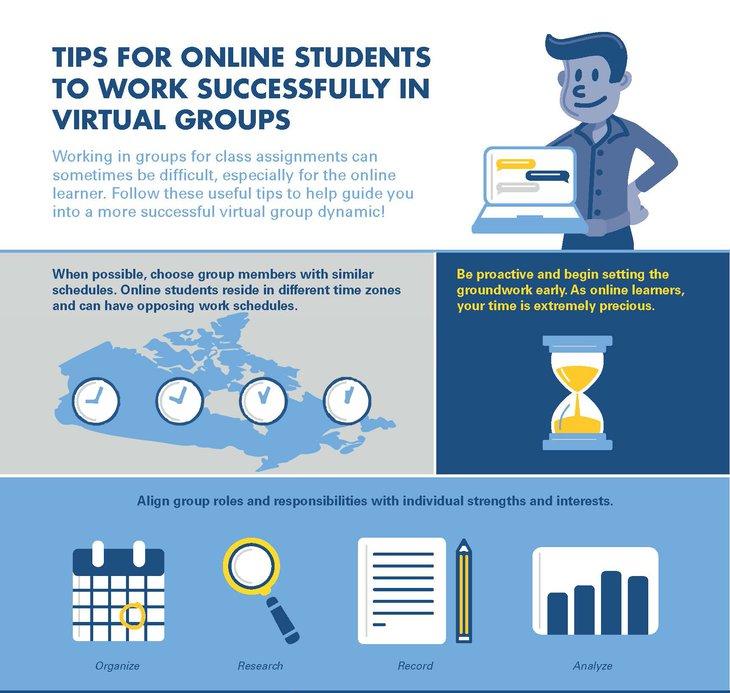
Transcript:
Tips for online students to work successfully in virtual groups
Working in groups for class assignments can sometimes be difficult, especially for the online learner. Follow these useful tips to help guide you into a more successful virtual group dynamic.
When possible, choose group members with similar schedules. Online students reside in different time zones and can have opposing work schedules.
Be proactive and begin setting the groundwork early. As online learners, your time is extremely precious. Align group roles and responsibilities with individual strengths and interests.
Organize, research, record, and analyze.
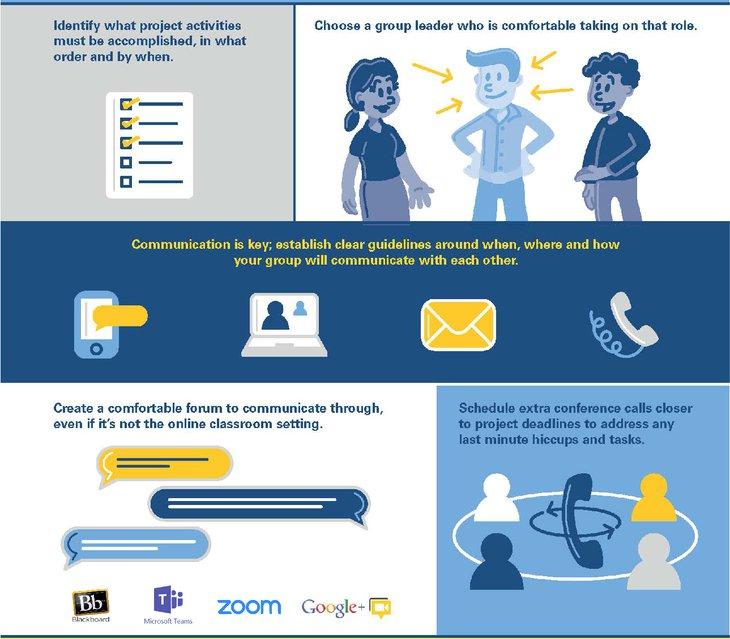
Transcript:
Identify what project activities must be accomplished, in what order and by when.
Choose a group leader who is comfortable taking on that role.
Communication is key; establish clear guidelines around when, where and how your group will communicate with each other.
Create a comfortable forum to communicate through, even if it’s not the online classroom setting. Some options are Blackboard, Microsoft teams, Zoom, or Google Hangouts.
Schedule extra conference calls close to project deadlines to address any last minute hiccups and tasks.

Transcript:
Always be honest, but respectful in a group. If either the project or a fellow group member is heading down a path you don’t agree with, speak up.
Ask your professor to implement mandatory peer evaluations. This strategy encourages equal participation by ensuring individual accountability.
Don’t be afraid to talk to your professor. Provide regular group updates, which can then be used to track progress and mediate concerns.
Source: Tips for participating in group work and projects online from Drexel University
A few extra tips...
Know your team and instructor.
- Get to know your team members. Getting a little personal with each team member can make it easier when it comes to sacrificing time to achieve a common learning goal. Also, get to know your online instructor and his or her teaching strategies. Engage him or her in an email dialogue.
Find a specific weekly time to meet.
- A team can’t function solely through email. Microsoft Teams meeting conversations often gets a point across verbally that 10 emails can’t. Plan the Microsoft Teams meetings at least once a week to keep everyone in sync.
Establish Clear Roles on the Team.
- An easy way to establish an efficient structure and avoid miscommunication later, assign yourselves separate roles based on your strengths and skills. Some roles include a facilitator to keep everyone on track, a recorder to take down notes, a checker to make sure everything is ready, and so on.
- Elect one person to be the “voice” for the final version of the written assignment. Having everyone write separately is fine for rough drafts, but taking a piecemeal approach to the final product can make it disjointed and confusing. The project comes from multiple authors, but give it one uniform voice in the final draft. Once the elected “voice” has edited together all the content, have them submit it to the group for review. Group members can then make edits or insert ideas to polish the final assignment.
Agree on the tools that you’ll use to collaborate.
- There are a lot of collaborative tools you can use like Office 365 or Google documents. Pick and agree on the collaboration and tracking methods before starting.
Handling Conflict Resolution
- Being prepared at the start of your teamwork can help with any conflicts that could arise later. You can create a team contract that states everyone’s roles, your goals, overall plan and conflict resolution strategy. Get everyone to sign the charter and abide by those rules.
- Conflict can be natural and a good opportunity for growth. Even with a plan and effective communication skills, it’s still possible a disagreement can happen. When it does, address it as soon as possible and take the time to listen to one another in order to come to a decision that works.
